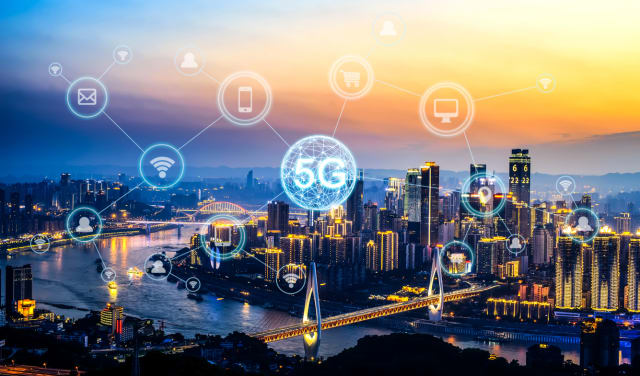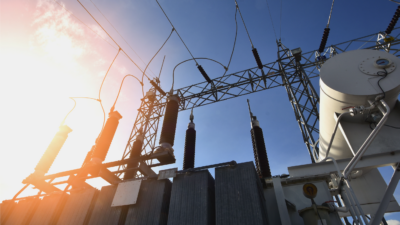As we reach the midpoint of this cellular standard, there’s a lot to look forward to for IIoT and smart city applications.
IEEE has sponsored this post.

It’s been six years since the first rollout of 5G, the cellular standard that promised to connect not just people but their devices as well. With millimeter wave (mmWave) signals that unlocked faster communication speeds than ever before, 5G was seen as the key to smarter factories, cars, and even cities.
At the midpoint of its generational cycle, 5G has yet to deliver substantially on its early promise. And as the lure of the still-distant 6G calls to those keen for the next big standard, it’s easy to lose sight of the developments happening with 5G right now. For engineers, 5G still presents an exciting opportunity to make our world smarter and more connected. Here’s what’s to come for the future of 5G.
Improving 5G coverage through private networks
To truly unlock the benefits of 5G for the industrial internet of things (IIoT) and smart cities, it’s imperative to improve 5G coverage. Telecoms are working to do this through the expansion of 5G standalone (5G-SA) network infrastructure, a freeing of the standard from the 4G network core on which many 5G networks are overlaid (5G non-standalone, or 5G-NSA). The true promise of 5G can only be achieved on a 5G-SA core, and telecoms are generally still in the early stages of this changeover.

For industries such as manufacturing, healthcare, logistics and transportation, one of the key ways to take advantage of 5G is to implement a private 5G network. Either self-managed or administered by a telecom partner, private 5G networks offer a reliable and low-latency communications system that can be scaled and tailored as needed. Of course, the perennial concern of cybersecurity is doubly important for these sensitive use cases, and 5G network operators will have to work closely with regulatory bodies to implement encryption protocols and enforce security standards.
Private 5G networks are ideal for connecting a high number of devices in real-time, such as in IIoT-enabled factories. Often these private networks employ 5G Reduced Complexity, or RedCap (also known as NR-Light), a lighter weight version of the standard that caters to use cases with low power, event-based devices such as industrial sensors and smart city applications.
Among communication service providers (CSPs) and related stakeholders, private networks are seen as the clear next step for 5G. In a 2023 5G industry survey sponsored by IEEE DiscoveryPoint for Communications, 59 percent of respondents cited 5G enterprise private networks as the most viable route to network monetization in the next two years. As a critical step for the telecom industry and enterprise customers alike, expect to see a rapid uptick in private 5G networks over the next few years.
Multi-access edge computing (MEC) and hyperscale cloud networks
Another important development in 5G is multi-access edge computing (MEC), which the 2023 5G industry survey points to as having played a key role in addressing the needs of enterprises since the dawn of 5G. MEC opens the edge of the network—such as cellular base stations—to be used as a local cloud to compute data right at the source, an essential characteristic for real-time processing as required by IIoT, and smart city applications like autonomous vehicles.
A 2023 report by Allied Market Research predicts that the MEC market will reach $102 billion by 2032, thanks in part to the expansion of 5G networks. Indeed, in the 2022 version of the 5G industry survey, respondents pointed to MEC as one of the top three 5G features with the greatest commercial significance (33 percent). However, the 2023 survey saw a dip to just 14 percent, signaling a potential slowdown in growth.
For enterprises, MECs are one of several solutions alongside standalone private networks, hyperscale cloud providers and even Wi-Fi 7, according to a May 2023 report from market research firm Dell’Oro Group that corroborates the survey’s findings. “We believe enterprises are evaluating all of these choices before moving forward with more aggressive MEC deployments,” said Dave Bolan, research director at Dell’Oro Group, in a press release at the time.
Ultimately, manufacturers and other enterprise customers must determine how to manage their rapidly increasing volumes of data and concomitant processing needs. Whatever their choice, 5G will play a key role.
5G-Advanced
The 5G spec itself is still evolving, and the latest release from the 3rd Generation Partnership Project (3GPP), Release 18, ushers in a new era of 5G called 5G-Advanced. 3GPP calls it the midpoint of 5G standardization, and though Release 18 is still being finalized, this year will see the first launch of 5G-Advanced networks and compatible devices. In a way, 5G-Advanced will serve as the bridge to 6G.

5G-Advanced will improve on all the key benefits of 5G, offering greater data speeds and lower latencies, higher throughput, more efficient use of spectrum and network resources, lower interference and greater signal quality, and ultimately a better experience for end users. Tests of the 5G-Advanced network have achieved greater than 10 Gbps downlink speeds.
“[Release 18], the initial release for 5G-Advanced, signifies the subsequent stage in the progression of 5G technology. 5G-Advanced aims to provide new functionalities extending beyond mere connectivity, thus unlocking a broader spectrum of sophisticated applications tailored to vertical industries and sectors,” said Puneet Jain, 3GPP TSG SA Chair, in a November 2023 update on Release 18 progress.
The timing of 5G-Advanced also pairs well with the rise in generative artificial intelligence (AI) that has impacted seemingly every industry over the past year or so, as 3GPP aims to enhance the use of AI and machine learning in Release 19 and beyond. Also on the agenda is the concept of non-terrestrial networks (NTNs), which will see 5G implemented with satellite architectures to provide the possibility of worldwide coverage.
Upskilling for 5G
It’s an understatement to say that tech changes fast. And even though cellular standards are comparatively slow moving, they are constantly evolving nonetheless. For the engineers who design wireless devices, develop and integrate industrial systems, create networks, or simply use them, it’s important to stay up to date with the changes.
“For many in the industry there is still a growing need to reskill and upskill their staff to handle new technologies — e.g. new applications and 5G’s cloud-native systems and architecture — more efficiently and effectively,” reads the 2023 5G industry survey.

The deployment of 5G capabilities continues to drive innovation, enhance productivity and encourage new business models and services while pushing companies to remain competitive and adopt new standards or technologies. In the case of 5G, as this technology evolves, it is more important than ever for engineers and researchers to have access to cutting-edge and reliable information that applies to their workflows. IEEE DiscoveryPoint for Communications is an all-in-one platform built for engineers in the telecommunications industry to design and develop technology solutions. Curated by subject matter experts, this platform brings communications-focused information together from hundreds of vetted sources. Quickly find the technical information you need and extract key insights from your results with machine learning. With IEEE DiscoveryPoint, spend less time searching and more time discovering solutions to optimize, improve and innovate high-quality products.
To learn more, request a demonstration to see the ways IEEE DiscoveryPoint can help improve your team’s product design workflow.



